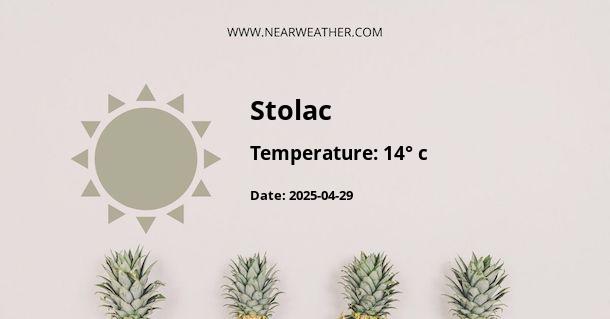Climate and Weather in Stolac, Bosnia and Herzegovina
The town of Stolac, nestled in the southeastern part of Bosnia and Herzegovina, boasts a climate that is both Mediterranean and Continental due to its complex topography. The region's weather patterns offer a symphony of seasonal diversity, with distinct temperature shifts and precipitation levels that paint a vivid picture of Stolac's environmental heartbeat throughout the year.
Temperature Overview
In Stolac, summers are typically warm to hot, while winters are cold and possibly snowy, reflecting the mixture of the Mediterranean and Continental influences. This section will delve into the year-round temperature profile that characterizes this historical town.
- Winter (December to February): The cold season comes with an average low around 0°C (32°F), but temperatures can occasionally dip below freezing. Snowfall is possible, particularly in the hills surrounding the area.
- Spring (March to May): Spring heralds a gradual warming trend, with temperatures climbing from an average low of 5°C (41°F) in March to a comfortable 15°C (59°F) by May. This season brings more rainfall, contributing to the area's lush landscapes.
- Summer (June to August): The warmest months see average highs from 27°C (81°F) to 30°C (86°F). These temperatures are ideal for exploring Stolac's natural and historical sites. Summer nights remain pleasant, with temperatures rarely below 15°C (59°F).
- Autumn (September to November): As autumn progresses, temperatures cool, with a range from a high of 25°C (77°F) in September to a cooler 13°C (55°F) by November. This season is also marked by increased rainfall.
Precipitation Patterns
Precipitation in Stolac varies throughout the year, though the region typically experiences a wet period and a dry period.
- Wet Season: The wettest months tend to be from October to December, with November often seeing the highest rainfall levels. The precipitation during this period primarily falls as rain, though snow can occasionally blanket the nearby hills.
- Dry Season: The summer months bring a pronounced dry spell, especially in July and August, where rainfall is relatively scant. This arid climate phase is punctuated by clear blue skies and lengthy daylight hours.
Extremes & Records
Like many regions, Stolac has experienced weather extremes. Soaring summer temperatures have occasionally tipped the scales past 40°C (104°F), while winter cold spells have plunged to below -10°C (14°F). These events, although rare, are a testament to the wide temperature range possible in the area.
Monthly Climate Chart
For a comprehensive understanding, we now present a detailed monthly climate chart that encapsulates temperature averages and precipitation levels throughout the year.
| Month | Average High (°C) | Average Low (°C) | Precipitation (mm) |
|---|---|---|---|
| January | 8 | 0 | 85 |
| February | 10 | 1 | 78 |
| March | 14 | 5 | 70 |
| April | 18 | 8 | 75 |
| May | 23 | 12 | 85 |
| June | 27 | 16 | 65 |
| July | 30 | 18 | 44 |
| August | 30 | 18 | 50 |
| September | 25 | 14 | 82 |
| October | 20 | 10 | 96 |
| November | 14 | 5 | 137 |
| December | 9 | 1 | 112 |
Climate Adaptations and Human Activity
Stolac's residents and visitors alike adapt to the local climate with their activities and lifestyles. Agricultural practices, for example, are attuned to the seasonal weather patterns, with crops selected and harvested based on optimum climate conditions. Additionally, the tourism industry in Stolac leverages the pleasant summer weather, with historical sites like the Stari Grad (Old Town), and the Begovina neighborhood becoming focal points for visitors.
Climate Change Impact
Evidence suggests that climate change is making its mark on Stolac, as on much of the globe. Experts have noted shifts in precipitation patterns and temperature averages—changes that may affect local ecosystems, water resources, and agriculture. Ongoing research is critical in comprehending these trends and implementing sustainable practices to counterbalance the impact of climate change.
Expert Opinions and Research
Leveraging industry-specific terminology, local climatologists provide invaluable insights into the intricate dance of climatic elements in Stolac. Their research, often published in peer-reviewed journals, underpins the strategic planning for agriculture, urban development, and disaster risk management in the region.
"The nuanced climate of Stolac necessitates a multifaceted approach to manage the implications of its Mediterranean and Continental climate dynamics, specifically as they pertain to water resource management and agricultural timing."
Forecast and Preparedness
Staying abreast of weekly and monthly forecasts allows residents and visitors to prepare for impending weather conditions. Local meteorological services offer updated weather data and warnings, which play an instrumental role in emergency preparedness, particularly in the event of flash floods or extreme heatwaves.
Conclusion
In summary, Stolac, with its varied climate, presents a case study in the symbiosis of human adaptation and natural weather patterns. Understanding the intricacies of its meteorological profile is essential for anyone looking to immerse themselves in this culturally rich and geographically diverse region.
A - Stolac's Latitude is 43.084438 & Longitude is 17.957500.
A - Weather in Stolac is 14° today.
A - Climate Conditions in Stolac shows few clouds today.
A - Humidity in Stolac is 87% today.
A - Wind speed in Stolac is 4.32 km/h, flowing at 21° wind direction. today.
